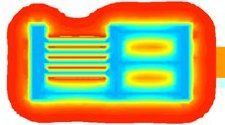
In June 2008 the UK Government published a 'White Paper' as part of the "Managing Radioactive Waste Safety" (MRWS) programme to provide a framework for managing the UK's higher activity radioactive wastes. The White Paper identifies that there are benefits to disposing all of the UK's higher activity wastes at the same site, and this is currently the preferred option. Working with Galson Sciences Ltd., Quintessa have recently undertaken a project for NDA RWMD to assess the implications of this preferred option for the operational and post-closure performance of a Geological Disposal Facility (GDF).
The different types of waste will have different packaging and will require different Engineered Barrier Systems (EBS). Therefore the GDF is likely to comprise two or more co-located modules, with each module containing specific types of waste with a specific EBS. The study considered a GDF comprising one module for ILW and some LLW that is not suitable for disposal to the LLWR, and a second co-located module for HLW and SF. The potential Thermo-Hydro-Mechanical-Chemical (THMC) interactions between the modules were identified and analysed for a range of potential host rocks and disposal concepts (packaging and EBS). The most significant potential interactions relevant to the current stage of the MRWS programme were analysed in further detail using dimensionless analyses, and 1D and 3D models for an illustrative GDF layout. The implications of disposal of U and Pu stocks that are not currently considered to be waste were assessed, e.g. for the GDF footprint and with regards to criticality issues.
A paper providing an overview of the study was presented at the ICEM '09 conference. A second paper describing the development of underpinning 3D coupled gas generation and multi-phase flow GDF resaturation models, using Quintessa's QPAC code, was also presented. The co-location study QPAC models were further developed for the ICEM paper, and these updated models will feed into the EC FORGE project. The co-location study report (Watson, S., Hicks, T., Towler, G., Reedha, D., Paulley, A., Baldwin, T., and Bond, A. 2009. PCPA: Consideration of a co-located GDF in the safety case) is available from the NDA RWMD bibliography.